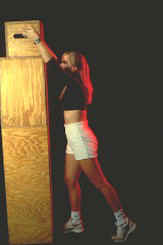
FCEase Manual

 |
FCEase Manual |
 |
Safe Manual Handling Techniques
Much discussion and critical assessment has been carried out over the past few years by a group of dedicated professionals resulting in a series of Consensus Meetings. [See Consensus Meetings on Safe and Effective Lifting - Cumberland College of Health Sciences University of Sydney in conjunction with the Institute for Fitness Research and Training Incorporated (S.A.)]
These techniques have been adopted by WorkHab and have been well used in a practical sense. However, the consensus meetings took information that most people are using and teaching and compiled it into a logical and concise format that is thorough, and easy to use for both teaching and assessment. WorkHab then created a way to score the techniques.
It has been accepted that the techniques be taught on the basis of Manual Handling Principles rather than a 'safe lift' as the principles actually apply to other activities other than lifting, and can therefore be recognized and adapted to other work situations by the worker.
Scoring Safe Technique
Scoring of Safe Technique can be done throughout the F.C.E.
It can be useful in developing your observation skills as well as developing protocol for recommendations for further manual materials handling training. The scoring is based on the five (5) principles of safe manual handling.
These principles are:
Stance
-wide steady base of supportPosture
-neutral spinal curves throughout lift
Leverage -keep loads close and where possible in the range of center of gravityTorque
-no spinal twisting particularly of low back
Pacing and timing -keep movements smooth and controlled at all times. No jerking.
By referring to the principles in this order, teaching procedures can be facilitated by addressing deficits accordingly. Usually if stance and posture are addressed well, leverage, torque and pacing will follow as a matter of course.
The scoring is done by a simple 0 to 4 scale with '0' being no adherence to the principle involved and '4' being the highest score.
The five (5) principles then have a combined score out of a total of 20.
This can then be multiplied by five (5) to obtain a percentage (%) score which then can be used to evaluate the technique.
Stance:
Ideal placement of feet at hip/shoulder width or slightly greater and a stable stance throughout all tasks is observed. Ideal stance throughout all tasks including overhead work and load transfer activities.| 4 3 2 1 0
|
Ideal stance throughout all tasks including overhead
work and load transfer activities. Problems with maintaining shoulder/hip width stance and some uncertainty with forward/backward foot placing. Requires frequent reminders about stance requirements. Minimal change of stance requirements with transfer or overhead work observed. Consistently narrow stance with lack of stability observed on occasion. No attention to stance during different positional activities. Unsafe situations observed Frequent reminders given but little change in stance patterns
observed. Totally unsatisfactory and unsafe patterns observed |
 |
Posture: Ideal maintenance of normal lordosis throughout all working activities.
| 4 3 2 1 0
|
Normal curvature of the spine observed throughout all
activities. Steady control of movement and stability noticed in low back and pelvic
region. Some loss or increase of lordosis noticed during some activities but easily corrected and maintained during greater percentage of activities. Loss of lordosis occurs during more than 50% of activities with increased lordosis observed with overhead lifts. Frequent loss of lordosis in low lifting positions not easily corrected during the activity. Frequent increased lordosis during overhead work. Unable to maintain normal curvature of the spine during any lower body position or position above head height. Unsatisfactory and unsafe technique observed frequently. |
 |
Leverage: Keeping loads as close as practicable to the
center of gravity.
| 4 3 2 1 0
|
Observation of adequate leverage factors throughout the
procedure. Any activity requiring reaching forward or across had the leverage factor
minimized by a change of posture to alter the position of the center of gravity.Several occasions where leverage was
compromised but corrected when reminded.
Frequent occasions where leverage was compromised but improved with reminders. Frequent compromised leverage with little or no attempt to allow for corrective positioning. Unable to grasp the concept of leverage and demonstrated frequent
situations where leverage factors rendered the activity unsafe. |
 |
Torque:
No rotation of the shoulder relative to the pelvis while undertaking work positions.| 4 3 2 1 0
|
Observation of good technique where spinal torque is
controlled by posture, stance and other factors. Several occasions where torque of the low back was observed but was able to be corrected using a variety of changes in posture, stance and other methods. Frequent occasions where torque was a problem particularly if occurred in flexion or extension postures. These were corrected with reminders. Frequent occasions where torque was observed but little attempt made to correct the problem. Continued problems with twisting of the trunk which was not easily corrected and not compensated adequately by use of body positioning. Unsafe situations observed.
|
 |
Pacing and Timing:
Involves the use of controlled and smooth movement patterns throughout the testing procedures.| 4 3 2 1 0
|
Observation indicates smooth controlled movements at
all times throughout testing even with progressively heavier loads. Occasions noticed where the load is not fully controlled resulting in jerky or faster/slower movements. Frequent occasions observed where loads are banged on the table/bench or jerked on initiation of the lift, but corrected with reminders. Loads banged and jerked frequently. On occasions, heights are misjudged and at times definitely out of control. Observed occasions of sharp acceleration or deceleration of movements, misjudging of heights and generally unsafe procedures throughout testing.
|
 |
| Factor | Point Score | Percentage |
| Stance | /4 | % |
| Posture | /4 | % |
| Leverage | /4 | % |
| Torque | /4 | % |
| Pacing and Timing | /4 | % |
| Total Score: | /20 | % |
How this information can be used is up to the evaluator.
A recommended interpretation of the data would be:
Example 1
| Factor | Point Score | Percentage |
| Stance | 3/4 | 75% |
| Posture | 2/4 | 50% |
| Leverage | 1/4 | 25% |
| Torque | 4/4 | 100% |
| Pacing and Timing | 3/4 | 75% |
| Total Score: | 13/20 | 65% |
This score of 65% indicates a need for further manual handling training with emphasis on stabilizing posture and correcting the leverage factors. Examples of this may refer to poor overhead lifting and bending at the waist to reach using postures which in turn compromise safety.
Example 2
| Factor | Point Score | Percentage |
| Stance | 3/4 | 75% |
| Posture | 3/4 | 75% |
| Leverage | 4/4 | 100% |
| Torque | 1/4 | 25% |
| Pacing and Timing | 3/4 | 75% |
| Total Score: | 14/20 | 70% |
Even with 70% safe lifting scored, a 1/4 score in torque is an unacceptable safety risk
and should be highlighted for attention.
 |